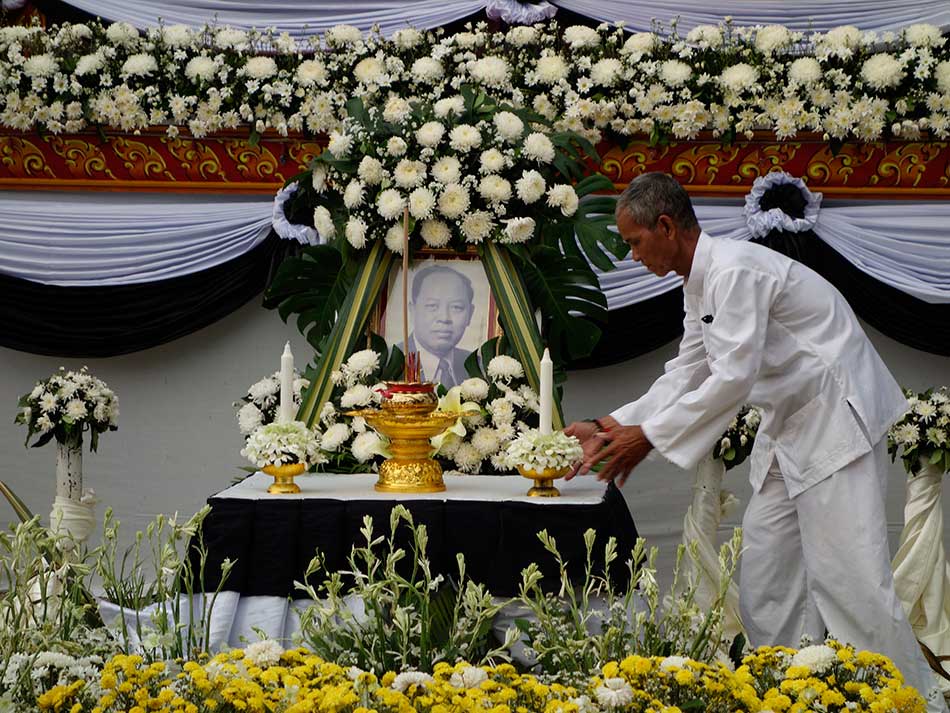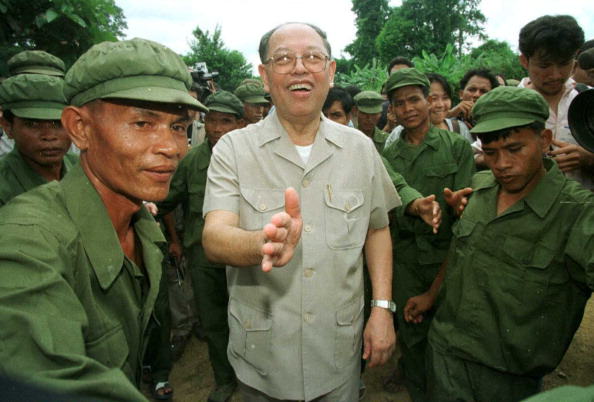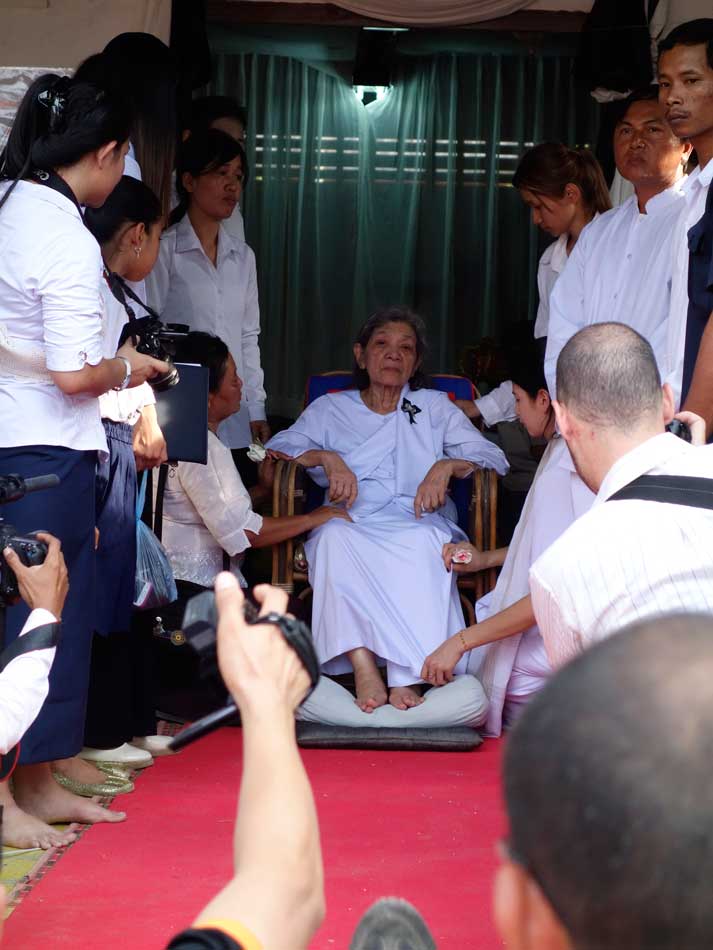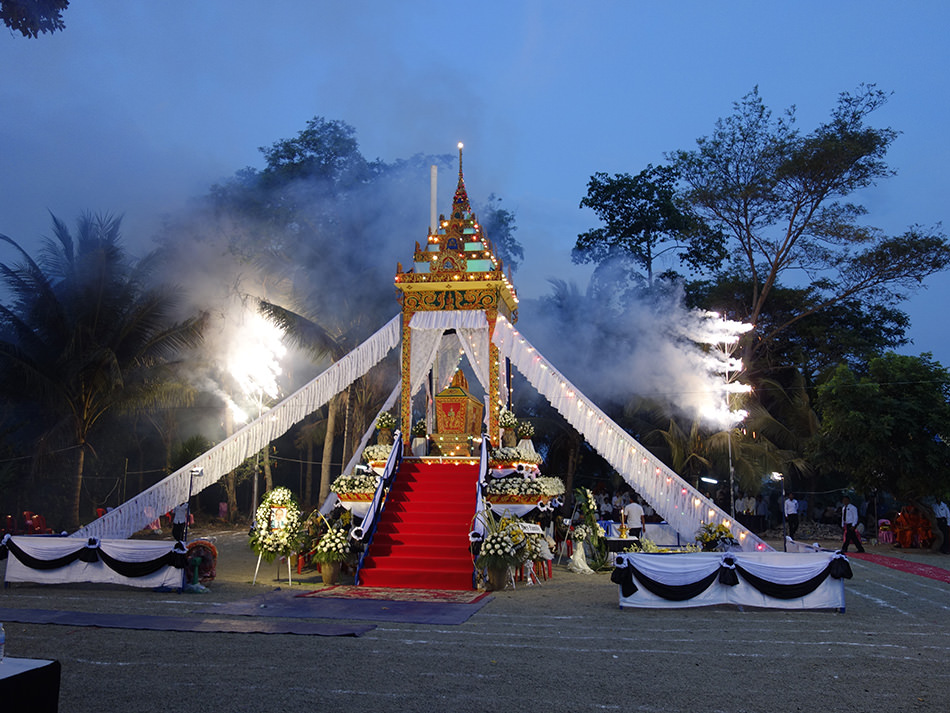It could have been the setting of any Cambodian notable’s funeral. There was a large wooden house. There was a tall, terraced pyre in the dirt yard. The case for the coffin was topped with a silhouette of Angkor Wat. Rows of chairs had been arranged under pink canopies with hanging fans. Orange fish soup was bubbling in vats out back. It was the familiar scene of a grown son and three daughters, dressed all in white, preparing to welcome hundreds of villagers and monks and dignitaries to send off their deceased father with the appropriate pomp.
But this was Malai, a tidy little town in Cambodia’s northwest that for many years has been an enclave for Khmer Rouge holdouts. And the elder being commemorated was Ieng Sary, Pol Pot’s foreign minister and a member of his standing committee, who died last month at eighty-seven while on trial for assorted mass crimes before a UN-backed tribunal.
Ieng Sary had retreated here when, after the Khmer Rouge’s fall from power in 1979, members of the former regime started an insurgency from several redoubts along Cambodia’s border with Thailand. By the mid-1990s, these remnant forces were losing steam and support, and Prime Minister Hun Sen—who is still very much in power today—struck a deal with some of their more pragmatic leaders: abandon the guerrilla war and get your fighters to defect, and I will let you be. Ieng Sary and his people—including Ieng Thirith, his wife and the Khmer Rouge’s minister for social affairs—were able to live free, and comfortably enough, in this gem- and timber-rich area. At least until 2007, when they and a few others were arrested as leaders and emblematic figures in the regime that killed some 1.7 million Cambodians between 1975 and 1979.
And so it was in Malai that on March 21, an auspicious seven days after his death, the Khmer Rouge’s foreign minister received his last rites. And on this day, his head and eyebrows shaved for the occasion, it was Ieng Vuth, Ieng Sary’s only son and the deputy governor of the neighboring province of Pailin, who would play host to a reunion of Khmer Rouge die-hards. Plain, pathetic, or powerful, these were the bodyguards and the messengers, the cooks and the photographers, the translators and the generals who had served Pol Pot.
For much of the morning, before many of those guests had arrived, the crowd was mostly villagers and the atmosphere casual and welcoming. Rice-noodle soup and cold bottled water were offered readily. In the room where Ieng Sary’s coffin lay, next to wreaths bearing cryptic blessings (“To be born, get old, be sick, and die”), a few old ladies and a little dog were slouched on the floor, listening to a radio. Outside, some ninety monks chanted for a long while and then followed a band of white cloth around the pyre, gathering alms: water, small amounts of cash, and many packets of instant noodles. It was just the kind of Buddhist ritual that the Khmer Rouge had ruthlessly banned.
Some of the people best trained in explaining away such contradictions, the members of Ieng Sary’s legal team, sat by the front door, near the family. It was a privilege that forced all nine of them to stay still for some very hot hours and left them at the mercy of prowling reporters. One journalist asked Ieng Vuth who was paying for the ceremony and was met with stony silence. The woman then turned to Michael Karnavas, Ieng Sary’s American lawyer, whose fees have been covered by the United Nations because his client was officially found indigent: what about the recent allegations that Ieng Sary had a Hong Kong bank account with $20 million in it?
“I’ve heard the rumors; I haven’t seen proof,” Karnavas answered.
“So, you’re saying he had no money?” she continued.
Perceiving a trap in her recasting, he said, “Don’t fuck with me.”
Karnavas was more short-tempered than usual. During the long drive up from Phnom Penh the day before, he had let out, unprompted and in a tone of sullen disbelief, “Five years and five months.” That was the time he had worked on the case, and it was longer than Pol Pot’s rule. In that period, he had contested almost every conceivable legal point and procedure—filing more than five hundred briefs, motions, memos, and letters—while at the same time trying to make Ieng Sary disappear from view, keeping him quiet during hearings or out of the courtroom altogether. Now he had been one-upped by his own client’s death.
Advertisement
So had the court. After seven years and more than $170 million, much of it paid for by foreign donors, the Khmer Rouge tribunal (formally known as the Extraordinary Chambers in the Courts of Cambodia) has convicted just one man, Kaing Guek Eav (known as Duch), of war crimes and crimes against humanity for overseeing the torture and execution of almost 13,000 prisoners at the S-21 security center in Phnom Penh. Of the four Khmer Rouge leaders indicted in the court’s second case, only the regime’s chief ideologue Nuon Chea and its head of state Khieu Samphan remain in the dock. The charges against Ieng Thirith—Ieng Sary’s once fearsomely clever wife—were suspended last September after court-appointed doctors determined she was mentally unfit.
Ieng Thirith had rarely been seen since her release, and as soon as she arrived at her husband’s cremation in Malai, it was clear that the doctors and the judges had been wise to let her go. An SUV drove up discreetly to the front door in the early afternoon, delivering the shriveled eighty-one-year-old widow into the arms of a young man; he whisked her indoors, cradled, with her head thrown back over his elbow. Later, when she was carried back outside seated on a chair, queen-like, for a mysterious public viewing, she seemed capable only of clenching her ankles awkwardly together and giving the horizon a glazed look.
Mid-afternoon and it was time to bring out Ieng Sary’s coffin. The steady trickle of arriving guests had swelled into a motley assembly of people with long pasts and, in some cases, missing limbs. A group of 150 or so gathered behind Ieng Vuth; almost all, including those who had testified at the dead man’s trial, wore the customary white tops and black bottoms. A rope tied around his forehead, Ieng Vuth pretend-dragged his father’s coffin around the cremation mount. He circled it three times, every so often raising a bow to shoot an arrow into the brush.
After the coffin was placed on top of the pyre, Ieng Thirith was painstakingly escorted over to it. Pointing to the portrait among the flowers, one daughter said to her: “Do you see the photo? That’s Papa.”
“Is Papa OK?” Ieng Thirith asked.
“Papa is going to his previous hometown!”
“Papa is dying?”
“Yes, he is dead.”
“Papa, please rest in peace.”
The daughter wrapped her arms around her mother’s waist to pull her away. Ever irascible, Ieng Thirith brushed off her hands. That won the old lady a couple more minutes of teetering there, but she was soon led to an awaiting SUV and driven away.
Sitting on a plastic chair near the entrance to the property was Suong Sikoeun, a longtime neighbor in Malai who had once been in charge of propaganda in Ieng Sary’s foreign ministry. He must have taken to his job: after lecturing to one journalist that terrorism does much more damage than all-out war, he said that the legacy of the Khmer Rouge should be evaluated not by a court, but by a committee of learned academics.
Next to him was Nhem En, busy distributing business cards that said, in English, “Khmer Rouge Member 1975–1995.” Considering that the regime collapsed in 1979, this suggested something about the tenacity of the man’s loyalties. “Tuol Sleng Prison Photographer 1976–1979” was a more dubious admission still, not least for being partly fabricated. This was the prison, also known as S-21, that Duch, who is now serving a life sentence, once ran. Nhem En was just a photographer’s apprentice back then, but he has for years tried to exaggerate his part in taking the mug shots of newly admitted detainees who were later tortured and killed.
Suddenly the crowd at the entrance seized up. Ieng Vuth and his sisters lined up at the property’s edge. Sirens. Another SUV. A shuffle. A middle-aged man in a dark suit and dyed black hair appeared, a pretty, pasty-white-faced woman in tow. It was Y Chhean, the governor of Pailin—and Ieng Vuth’s boss—accompanied by his wife.
Once a bodyguard of Pol Pot’s and a Khmer Rouge commander, Y Chhean was among those who in the mid-1990s had turned themselves over to the Hun Sen government. Like Ieng Sary, he had transformed a bit of northwestern Cambodia into a personal domain. Unlike him, he wasn’t arrested in 2007: he hadn’t been senior enough during the Pol Pot years to interest the Khmer Rouge court. But now he was somebody. He was an appointed official of the all-powerful governing party of Prime Minister Hun Sen. And today, just a few months before general elections, he would be doing the honors at the cremation of a suspected mass murderer.
Advertisement
Y Chhean was handed a rod with a lit tip. He held it up to a long wire connected to four posts around the pyre. Fuses whistled. White lights swirled up and down the poles. Firecrackers crackled all around. On the pyre itself, little candy-colored bulbs started throbbing. The Bose speakers nestled in surrounding trees blared a bestial roar: supposedly like the scream of an elephant, it was meant to scare off spirits. Fireworks were set off. The cremation had started.
Over the next few hours, as Ieng Sary, now a snake of grey smoke, slowly climbed up the darkened sky, the guests and their hosts went their separate ways. Ieng Vuth, who had just taken a vow of mourning, ostensibly retreated to a state of contemplation. Ieng Thirith withdrew to la-la land. Y Chhean returned to campaigning for the winning party in a foregone election. And Karnavas, the lawyer without a case, went back to thinking about the legal motions that will forever be left undecided: “Such wonderful appeals! Such wonderful issues!”





